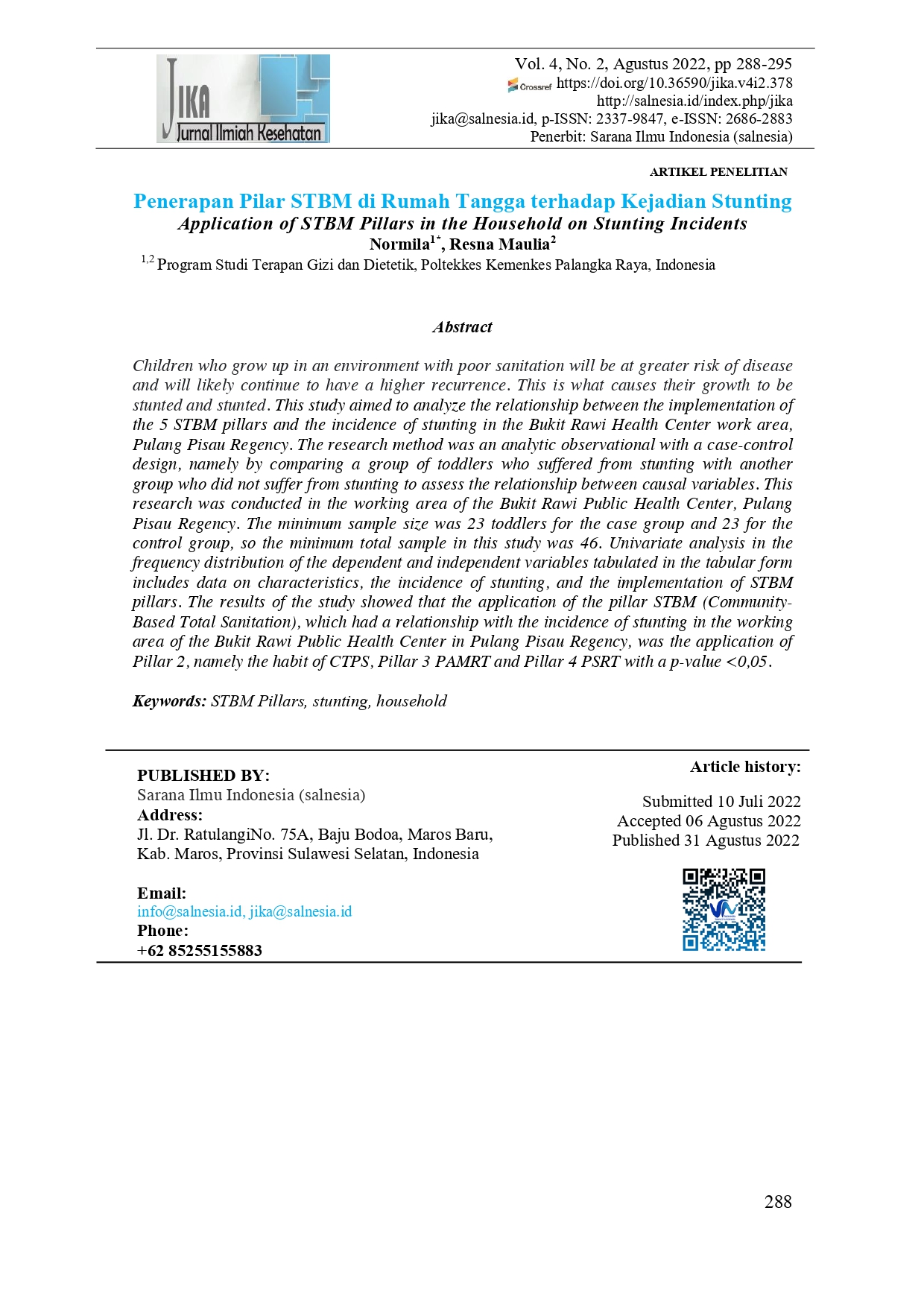Application of STBM Pillars in the Household on Stunting Incidents
DOI:
https://doi.org/10.36590/jika.v4i2.378Keywords:
STBM Pillars, stunting, householdAbstract
Children who grow up in an environment with poor sanitation will be at greater risk of disease and will likely continue to have a higher recurrence. This is what causes their growth to be stunted and stunted. This study aimed to analyze the relationship between the implementation of the 5 STBM pillars and the incidence of stunting in the Bukit Rawi Health Center work area, Pulang Pisau Regency. The research method was an analytic observational with a case-control design, namely by comparing a group of toddlers who suffered from stunting with another group who did not suffer from stunting to assess the relationship between causal variables. This research was conducted in the working area of the Bukit Rawi Public Health Center, Pulang Pisau Regency. The minimum sample size was 23 toddlers for the case group and 23 for the control group, so the minimum total sample in this study was 46. Univariate analysis in the frequency distribution of the dependent and independent variables tabulated in the tabular form includes data on characteristics, the incidence of stunting, and the implementation of STBM pillars. The results of the study showed that the application of the pillar STBM (Community-Based Total Sanitation), which had a relationship with the incidence of stunting in the working area of the Bukit Rawi Public Health Center in Pulang Pisau Regency, was the application of Pillar 2, namely the habit of CTPS, Pillar 3 PAMRT and Pillar 4 PSRT with a p-value <0,05.
Downloads
References
Fitri N, Widiawati N, Ningtyas RP, Sarnyoto FDA, Nisa W, Ibnistnaini W, Ardha MD, Aima Q, Salmanto S, Novitasari S. 2022. Strategi Gerakan Cegah Stunting Menggunakan Metode Sosialisasi di Desa Darakunci, Kabupaten Lombok Timur. Jurnal Pengabdian Inovasi Masyarakat Indonesia, 1(2): 80–86. https://doi.org/10.29303/jpimi.v1i2.1471.
George C, Oldja L, Biswas S, GO JPL, Kosek M. 2015. Geophagy is associated with environmental enteropathy and stunting in children in rural Bangladesh. Am J Trop Med Hyg, 96(6): 1117.
Hayward J, Huang Y, Yost C, Hansen L, Lake C, Tong A. 2019. Lateral flow sand filters are effective for removal of antibiotic resistance genes from domestic wastewater. Water Res, 162.
Imani N. 2020. Stunting Pada Anak: Kenali dan Cegah Sejak Dini. Hijaz Pustaka Mandiri: Yogyakarta.
Kemenkes [Kementrian Kesehatan]. 2017. Prosiding Promkes. Jakarta: Kemenkes RI.
Kemenkes [Kementrian Kesehatan]. 2022. Kejar Stunting Turun Hingga 14%, Kemenkes Sasar Perbaikan Gizi pada Remaja Putri. Jakarta: Kemenkes RI.
Kemenkes [Kementrian Kesehatan]. 2018. Situasi Balita Pendek (Stunting) di Indonesia. Jakarta: Pusdatin Kemenkes RI.
Kesling Poltekkes. 2020. Sanitasi for All. Kalimantan: Poltekkes Kemenkes Palangka Raya.
Lopa AFA, Helvian FA, Maidin S. 2022. Hubungan Pelaksanaan Lima Pilar Sanitasi Total Berbasis Masyarakat dengan Kejadian Stunting Penerbit?: Fakultas Kedokteran Universitas Muslim Indonesia. UMI Medical Journal, 7(1): 26–36.
Maliga I, Hasifah H, Antari GY, Rafi’ah R, Lestari A. 2022. Pengaruh Indeks Risiko Sanitasi Terhadap Kejadian Stunting di Kecamatan Moyo Utara. Jurnal Kesehatan Lingkungan Indonesia, 21(1): 50–58. https://doi.org/10.14710/jkli.21.1.50-58.
Matondang I. 2021. Analisis program sanitasi total berbasis masyarakat (STBM) pilar cuci tangan pakai sabun pada anak SD. Jurnal SAGO, 3(1).
Mukaramah N, Wahyuni M. 2020. Hubungan Kondisi Lingkungan dengan Kejadian Stunting pada Balita di Rt 08, 13 dan 14 Kelurahan Mesjid Kecamatan Samarinda Seberang 2019. Borneo Student Research, 1(2): 750–754.
Mukti D, Raharjo M, Dewanti N. 2016. Hubungan Antara Penerapan Program Sanitasi Total Berbasis Masyarakat (Stbm) Dengan Kejadian Diare Di Wilayah Kerja Puskesmas Jatibogor Kabupaten Tegal. J Kesehat Masy Undip, 4(3): 767–75.
Nisa SK, Lustiyati ED, Fitriani A. 2021. Sanitasi Penyediaan Air Bersih dengan Kejadian Stunting pada Balita. Jurnal Penelitian dan Pengembangan Kesehatan Masyarakat Indonesia, 2(1): 17–25. https://doi.org/10.15294/jppkmi.v2i1.47243.
Notoatmojo. 2017. Metodologi Penelitian Kesehatan.
Kemenkes RI. 2018. Situasi Balita Pendek (Stunting) di Indonesia 2018; Pus Data Dan Inf Jkt: Jakarta.
Rahmadhita K. 2020. Permasalahan Stunting dan Pencegahannya. Jurnal Ilmiah Kesehatan Sandi Husada, 11(1): 225–229. https://doi.org/10.35816/jiskh.v11i1.253.
Torlesse H, Cronin A, Sebayang S, Nandy R. 2016. Determinants of stunting in Indonesian children: evidence from a cross-sectional survey indicate a prominent role for the water, sanitation and hygiene sector in stunting reduction. BMC Public Health, 16(1): 1–11.
Wibisono AM, Novi ACM, Dharmawan DK. 2020. Analisis Faktor Risiko Kejadian Diare Berulang pada Balita di Puskesmas Sumberjambe Kabupaten Jember. Journal of Agromedicine and Medical Sciences, 6(1): 51–51. https://doi.org/10.4324/9780203641712-12.
Widiastuti EN, Citerawati YW. 2019. Kajian Riwayat Penyakit Infeksi Dan Pemberian Asi Eksklusif Terhadap Kejadian Stunting Di Wilayah Kerja Puskesmas Bukit Rawi Kecamatan Kahayan Tengah Kabupaten Pulang Pisau. [Artikel]. Poltekes Palangka Raya.
Yuliani Soeracmad YS. 2019. Hubungan Sanitasi Lingkungan Rumah Tangga Dengan Kejadian Stunting Pada Anak Balita Di Puskesmas Wonomulyo Kabupaten polewali Mandar Tahun 2019. J-KESMAS: Jurnal Kesehatan Masyarakat, 5(2): 138. https://doi.org/10.35329/jkesmas.v5i2.519.

Downloads
Published
How to Cite
Issue
Section
License
Copyright (c) 2022 Normila, Resna Maulia

This work is licensed under a Creative Commons Attribution 4.0 International License.








